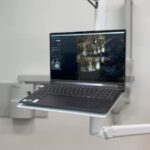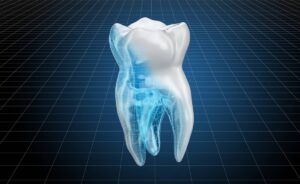Dentistry is a constantly evolving field, and technological advancements have played a significant role in improving patient care and outcomes. Several technologies are currently being used in dentistry, including digital imaging, computer-aided design and manufacturing (CAD/CAM), laser technology, AI, and 3D printing. These technologies enable dentists to diagnose and treat dental issues more accurately and efficiently, resulting in better patient outcomes. Additionally, technology has also made dental treatments more comfortable and less invasive for patients, leading to increased patient satisfaction. With the continued development of new technologies, the future of dentistry looks bright, with even more innovative and advanced solutions on the horizon.
The innovation in digital dentistry
Digital dentistry is an innovative approach to dental care that utilizes digital technologies to enhance diagnosis, treatment planning, and treatment outcomes. Research by Fortune Business Insights reveals that digitalization is the ultimate factor in the growth of the dental industry. It involves the use of computerized tools, such as digital scanners, CAD/CAM software, and 3D printers, to create precise and customized dental restorations. Digital dentistry also includes the use of intraoral cameras, which allow dentists to capture detailed images of a patient’s mouth and teeth. These images can be used for diagnosis and treatment planning, enabling dentists to identify issues earlier and develop more effective treatment plans. Additionally, digital technologies have made dental treatments more comfortable and less invasive for patients.
3D Printing In Dentistry
3D printing is becoming increasingly popular in dentistry, as it allows for the creation of highly accurate and customized dental restorations. The process typically involves several steps:
- Scanning: A digital scan of the patient’s mouth is taken using a special scanner, which creates a 3D image of the teeth and surrounding structures.
- Design: Using specialized software, a dental professional can design the restoration or prosthesis to fit the patient’s unique anatomy. The software can also simulate how the restoration will look and function in the mouth.
- 3D printing: Once the design is complete, the file is sent to a 3D printer that creates the restoration by building up layers of material, such as ceramics or polymers, according to the design specifications. The printer can create highly precise and intricate shapes that are difficult or impossible to achieve using traditional methods.
- Finishing: After the restoration is printed, it is polished and finished to ensure it fits comfortably and looks natural in the patient’s mouth.
3D printing in dentistry allows for more precise and efficient production of dental restorations, such as crowns, bridges, and dentures. This technology can save time and reduce costs for patients and dental professionals while improving the overall quality of care.
Latest dentistry Trend; The Development of Artificial Intelligence (AI)
Dentists are beginning to use AI (Artificial Intelligence) in dentistry to improve patient care and outcomes. AI has the potential to revolutionize the way dental professionals diagnose, treat, and prevent dental problems. Here are some ways dentists use AI in dentistry:
- Diagnosis and Treatment Planning: AI algorithms can analyze vast amounts of patient data, including x-rays, scans, and medical histories, to assist dentists in making more accurate diagnoses and treatment decisions. This technology can help dentists identify issues earlier and develop more effective treatment plans. which can lessen the time and effort specialists spend on dental charting by up to almost 70%, according to an FDA study.
- Predictive Analytics: AI can also be used to predict and prevent dental problems before they occur. By analyzing patient data, AI algorithms can identify patterns and risk factors for dental issues, allowing dental professionals to take proactive steps to prevent them.
- Prosthodontics: AI is being used to create more accurate and customized dental restorations, such as crowns, bridges, and dentures. AI algorithms can analyze patient data to create more precise digital impressions, which can be used to create restorations that fit more comfortably and function more effectively.
- Robotic-Assisted Surgery: AI is also being used to assist dental professionals in performing surgeries. Robotic systems can be programmed to perform precise and complex movements, reducing the risk of error during procedures.
AI has the potential to transform the field of dentistry, improving patient outcomes and providing more efficient and accurate dental care. As AI technology continues to advance, it is likely that we will see even more innovative uses of AI in dentistry in the future.
- 3 factors can affect the success of a single tooth dental implantSingle tooth dental implants have become a popular option for replacing missing teeth, providing patients with a long-lasting and natural-looking restoration. However, the success of a dental implant depends on several crucial factors that must be carefully considered before and after the procedure. In this text, we will focus on three essential factors that can… Read more: 3 factors can affect the success of a single tooth dental implant
- The 5 Best Toothpaste For Healthy Gums, According to DentistsWith so many types of toothpaste available on store shelves, it can be overwhelming to shop for the right one. However, finding the 5 best toothpaste for gums that are effective in preventing cavities and disease while also providing fresh breath and a bright smile is essential for improving your oral hygiene. The beneficial impacts… Read more: The 5 Best Toothpaste For Healthy Gums, According to Dentists
- The Latest innovations and trends in dentistry for 2023Dentistry is a constantly evolving field, and technological advancements have played a significant role in improving patient care and outcomes. Several technologies are currently being used in dentistry, including digital imaging, computer-aided design and manufacturing (CAD/CAM), laser technology, AI, and 3D printing. These technologies enable dentists to diagnose and treat dental issues more accurately and… Read more: The Latest innovations and trends in dentistry for 2023
- Life Changing Gum Graft SurgeryGum Graft Surgery Can Change Your Life Gum graft surgery is a dental procedure that involves taking gum tissue from one area of the mouth and placing it in another area to cover exposed tooth roots or to thicken existing gum tissue. This procedure is commonly performed to prevent tooth sensitivity, improve the appearance of… Read more: Life Changing Gum Graft Surgery
- Navident: The Better Way to Place Dental ImplantsAt Dr. Dowlatshahi’s practice, we are proud to offer Navident as the best way for our patients to get dental implants. Navident is a unique technology which has revolutionized the process of placing dental implants. It offers numerous advantages over conventional implant placement methods that make it a great choice for all of our patients.… Read more: Navident: The Better Way to Place Dental Implants





